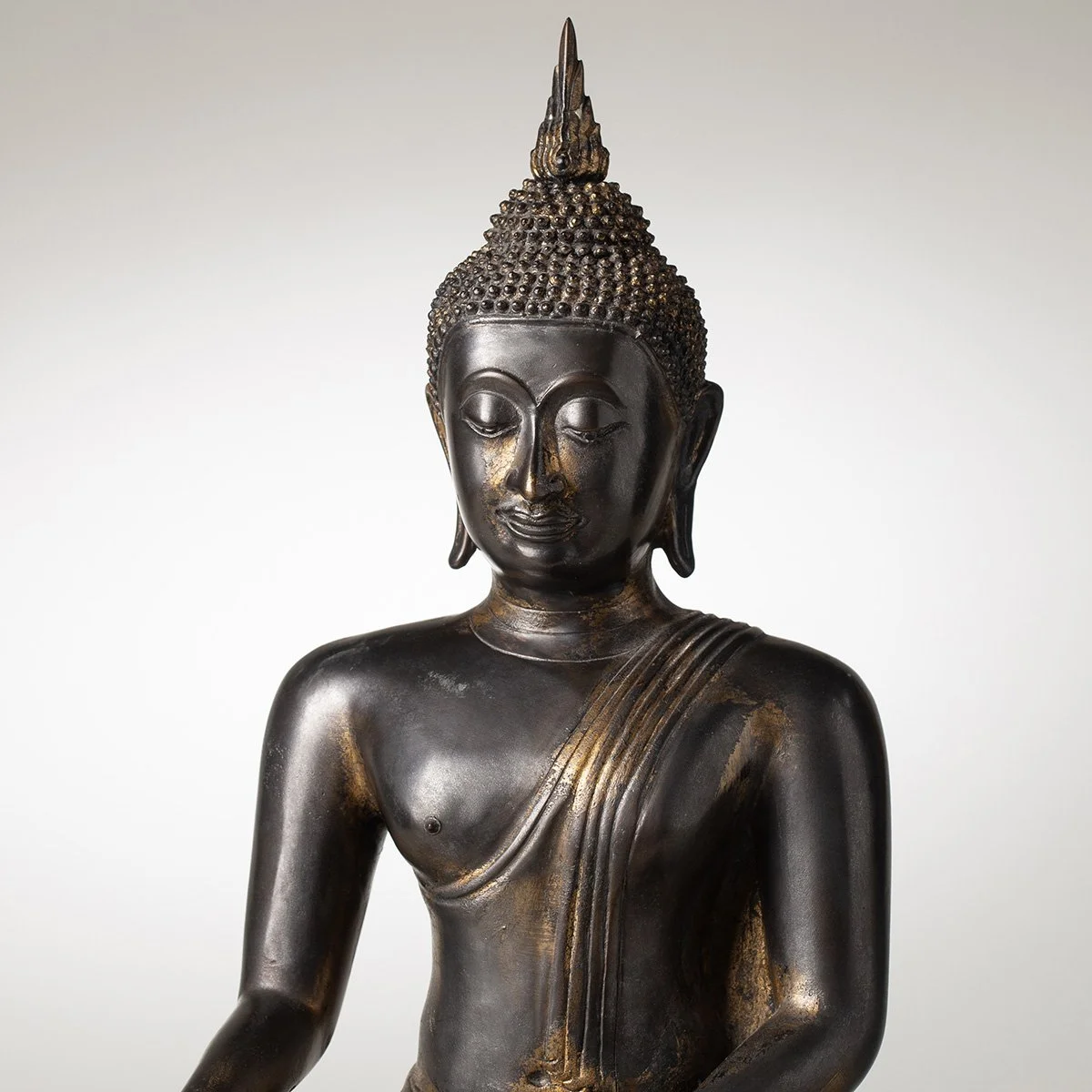 Image 1 of 7
Image 1 of 7

 Image 2 of 7
Image 2 of 7

 Image 3 of 7
Image 3 of 7

 Image 4 of 7
Image 4 of 7

 Image 5 of 7
Image 5 of 7

 Image 6 of 7
Image 6 of 7

 Image 7 of 7
Image 7 of 7








Fine Seated Gilt Bronze Buddha
Thailand – Early Rattanakosin Period
18th century
Height 18 1/4" Width 13 1/2"
Provenance: Steve Farr, Dallas, TX
Paul van Katwijk, Dallas, TX
This beautiful gilt bronze depicts the Buddha Shakyamuni (563-483 BCE) seated in the dhyanasana position high upon an ornately cast three-tiered base, emphasizing the sculpture’s sense of elegant symmetry. His left hand is held in dhyana mudra above his lap, symbolizing serene meditation and spiritual perfection. With his lowered right hand, the Buddha forms the bhumisparsha mudra, which can be translated as “gesture of touching the earth” in which the buddha touches the ground in order to call upon the earth to witness his enlightenment, having defeated the temptations of the evil Mara; a central theme in Thai Buddhist art. The buddha’s monastic sanghati robe is worn leaving the right shoulder bare, with a long section of cloth, representing his narrowly folded shawl, falling from his left shoulder to just beside the navel. Calm and serene, he gazes down with heavy-lidded eyes below gently arched brows. His full lips form a subtle smile, framed by pendulous earlobes; the elongated ears symbolizing the buddha’s ability to hear the cries of those who are suffering, and to reference his former princely status before his spiritual journey to enlightenment. The sculptor has masterfully rendered three subtle folds around the Buddha’s neck, representing the three virtues of conduct, concentration, and wisdom. Often interpreted in Buddhist art as snail shells, his hair is arranged in tightly curled ringlets. Adding to the sculpture’s energyand radiance, a flame of enlightenment rises from the top of his ushnisha, a cranial bump symbolic of the Buddha’s infinite wisdom.
The lovely surface patina of the bronze is polished and well worn, with only traces of gilt remaining. This seated buddha was cast in the early Rattanakosin period (c 1782), during which time the artistic influences of the previous Ayutthaya Kingdom (1351-1767) were still clearly visible in representations of the buddha, depicting him free of ornamentation and in simple monk’s robes. After the destruction of the Ayutthaya Kingdom by the Burmese, King Tak Sin the Great successfully drove out the invaders and reunified the country, establishing a new capital at Thonburi, a strategic port town at the mouth of the Chao Phraya River. Subsequently when Tak Sin was deposed, Thong Duang was chosen as king, known as Rama I, ushering in the Rattanakosin period and establishing the Chakri Dynasty which continues to reign over Thailand today. As the sculptural art of the Rattanakosin carried on the traditions of the previous Ayutthaya period, so too the art of the Ayutthaya was a continuation of the sculptural artistic traditions of the Sukhothai period(1238-1438), historically Thailand’s first kingdom
Thailand – Early Rattanakosin Period
18th century
Height 18 1/4" Width 13 1/2"
Provenance: Steve Farr, Dallas, TX
Paul van Katwijk, Dallas, TX
This beautiful gilt bronze depicts the Buddha Shakyamuni (563-483 BCE) seated in the dhyanasana position high upon an ornately cast three-tiered base, emphasizing the sculpture’s sense of elegant symmetry. His left hand is held in dhyana mudra above his lap, symbolizing serene meditation and spiritual perfection. With his lowered right hand, the Buddha forms the bhumisparsha mudra, which can be translated as “gesture of touching the earth” in which the buddha touches the ground in order to call upon the earth to witness his enlightenment, having defeated the temptations of the evil Mara; a central theme in Thai Buddhist art. The buddha’s monastic sanghati robe is worn leaving the right shoulder bare, with a long section of cloth, representing his narrowly folded shawl, falling from his left shoulder to just beside the navel. Calm and serene, he gazes down with heavy-lidded eyes below gently arched brows. His full lips form a subtle smile, framed by pendulous earlobes; the elongated ears symbolizing the buddha’s ability to hear the cries of those who are suffering, and to reference his former princely status before his spiritual journey to enlightenment. The sculptor has masterfully rendered three subtle folds around the Buddha’s neck, representing the three virtues of conduct, concentration, and wisdom. Often interpreted in Buddhist art as snail shells, his hair is arranged in tightly curled ringlets. Adding to the sculpture’s energyand radiance, a flame of enlightenment rises from the top of his ushnisha, a cranial bump symbolic of the Buddha’s infinite wisdom.
The lovely surface patina of the bronze is polished and well worn, with only traces of gilt remaining. This seated buddha was cast in the early Rattanakosin period (c 1782), during which time the artistic influences of the previous Ayutthaya Kingdom (1351-1767) were still clearly visible in representations of the buddha, depicting him free of ornamentation and in simple monk’s robes. After the destruction of the Ayutthaya Kingdom by the Burmese, King Tak Sin the Great successfully drove out the invaders and reunified the country, establishing a new capital at Thonburi, a strategic port town at the mouth of the Chao Phraya River. Subsequently when Tak Sin was deposed, Thong Duang was chosen as king, known as Rama I, ushering in the Rattanakosin period and establishing the Chakri Dynasty which continues to reign over Thailand today. As the sculptural art of the Rattanakosin carried on the traditions of the previous Ayutthaya period, so too the art of the Ayutthaya was a continuation of the sculptural artistic traditions of the Sukhothai period(1238-1438), historically Thailand’s first kingdom

